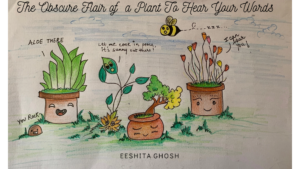
This COVID-19 pandemic helped me spend more time with plants growing in my balcony watering them every evening. One day my mother pointed out that a plant was no longer growing new leaves. This caught my attention and a little extra care brought it back to its greener days. Yes, it’s developing new leaves again! Aren’t you a little bit curious to see the plants? Well, I am excited to show them! I know it sounds funny but I love talking to them and this made me curious to know if they can hear me. That is when I started looking through the literature and was surprised to see that there are research labs working on this very aspect and have shown various results that prove that they can actually hear! It can be surprising for you like it was for me in the beginning.

“If even bacteria can signal one another with vibrations, why not plants”, said Monica Gagliano, a plant physiologist at the University of Western Australia in Crawley.
It has always made me curious how plants sense the environment even though they lack a nervous system per se. We had learned about the senses of plants to touch and light, however, it is seen that plants have acoustic senses as well.
“We tend to underestimate plants because their responses are usually less visible to us. But leaves turn out to be extremely sensitive vibration detectors,” says scientist Heidi Appel.
There are no ears that can be seen but plants do communicate through sound. It has been observed that chili plant grows faster in the vicinity of other plants by communicating with sound rather than chemicals.
Plants can also sense the munching of caterpillars. There are experiments done by Heidi Appel and Rex Cocroft of the University of Missouri, where they demonstrate that in response to caterpillar munching plants produced more mustard a chemical that caterpillars dislike. “Caterpillars react to this chemical defense by crawling away, so using vibrations to enhance plant defenses could be useful to agriculture,” Appel says.
Embolism that is the air bubble burst in the xylem emit ultrasonic sound about 300 kilohertz which can be detected by insects and animals. This is considered as one of the reasons how nearby plants understand that there is drought condition (air bubbles form due to high tension of water in the xylem that dissolves air) and develop drought resistance. It has been demonstrated that plants exposed prior to sound vibrations exhibit higher resistance to drought than grown in silence.
One of the interesting things observed was that corn seedling roots responded to sounds by leaning towards it and emitted clicks of the same tune. Plants can hear the flowing of water and bent towards as demonstrated by scientist Gagliano.
There are reports of plant’s acoustic senses where the flowers act as their ears. Evening primroses (Oenothera drummondii), can listen to buzzing of bees and produce sweeter nectar to attract the bees. Sweeter nectar means that the bees would stay for long and hence increasing the probability of pollen transfer. Experiments showed that about 20 percent more sugar in the nectar is produced when plants were treated with the buzzing of bees or similar frequency sound waves, however, there were no changes observed in silence or high-frequency sound. The shape of the flowers also helps them to trap the vibrations of the bees or insects flying by and also has the ability to finetune these vibrations by removing the vibrations caused by wind.
Gagliano also states that plants produce sound of their own and she aims to record these sounds and make them listen to other plants and observe whether they respond or not. There exist many unanswered questions and this may lead to the development of a new field in plant biology.

References and further reading:
- https://www.biorxiv.org/content/10.1101/507319v1
- https://www.livescience.com/27802-plants-trees-talk-with-sound.html
- https://blog.education.nationalgeographic.org/2017/05/24/can-plants-hear/
- https://www.calacademy.org/explore-science/do-plants-hear
- https://www.scientificamerican.com/article/can-plants-hear/
- https://www.ncbi.nlm.nih.gov/pmc/articles/PMC5647969/
By Eeshita Ghosh, Department of Biological Sciences, IISER Bhopal.
(Photos and Artwork are also by the author)
About the author:

Eeshita is a third-year BS-MS student at IISER Bhopal majoring in Biology. She is especially interested in molecular and plant biology. She loves painting and dancing other than reading interesting science articles and blogs. She also shows enough interest in sleeping, cooking new dishes and trying good food. This is her first blog and artwork for THQ and we hope to get more such incredible contributions from her in the future.
Read her other blogs for TQR: An Exemplar of Our Incredible Kinship With Plants and A Dream within a Dream
2 thoughts on “The Obscure Flair Of A Plant To Hear Your Words”